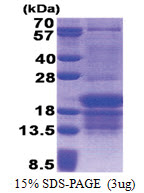PCBP1 (1-163, His-tag) Human Protein
Other products for "PCBP1"
Specifications
| Product Data | |
| Species | Human |
| Expression Host | E. coli |
| Expression cDNA Clone or AA Sequence |
MGSSHHHHHH SSGLVPRGSH MGSMDAGVTE SGLNVTLTIR LLMHGKEVGS IIGKKGESVK RIREESGARI NISEGNCPER IITLTGPTNA IFKAFAMIID KLEEDINSSM TNSTAASRPP VTLRLVVPAT QCGSLIGKGG CKIKEIREST GAQVQVAGDM LPNSTERAIT IAGVPQSVTE CVKQIC
|
| Tag | His-tag |
| Predicted MW | 19.6 kDa |
| Concentration | lot specific |
| Purity | >85% by SDS - PAGE |
| Buffer | Presentation State: Purified State: Liquid purified protein Buffer System: 20 mM Tris-HCl buffer (pH 8.0) containing 0.15M NaCl, 20% glycerol, 1mM DTT |
| Preparation | Liquid purified protein |
| Protein Description | Recombinant human PCBP1 protein, fused to His-tag at N-terminus, was expressed in E.coli and purified by using conventional chromatography techniques. |
| Storage | Store undiluted at 2-8°C for one week or (in aliquots) at -20°C to -80°C for longer. Avoid repeated freezing and thawing. |
| Stability | Shelf life: one year from despatch. |
| Reference Data | |
| RefSeq | NP_006187 |
| Locus ID | 5093 |
| UniProt ID | Q15365, Q53SS8 |
| Cytogenetics | 2p13.3 |
| Synonyms | HEL-S-85; hnRNP-E1; hnRNP-X; HNRPE1; HNRPX |
| Summary | 'This intronless gene is thought to have been generated by retrotransposition of a fully processed PCBP-2 mRNA. This gene and PCBP-2 have paralogues (PCBP3 and PCBP4) which are thought to have arisen as a result of duplication events of entire genes. The protein encoded by this gene appears to be multifunctional. It along with PCBP-2 and hnRNPK corresponds to the major cellular poly(rC)-binding protein. It contains three K-homologous (KH) domains which may be involved in RNA binding. This encoded protein together with PCBP-2 also functions as translational coactivators of poliovirus RNA via a sequence-specific interaction with stem-loop IV of the IRES and promote poliovirus RNA replication by binding to its 5'-terminal cloverleaf structure. It has also been implicated in translational control of the 15-lipoxygenase mRNA, human Papillomavirus type 16 L2 mRNA, and hepatitis A virus RNA. The encoded protein is also suggested to play a part in formation of a sequence-specific alpha-globin mRNP complex which is associated with alpha-globin mRNA stability. [provided by RefSeq, Jul 2008]' |
| Protein Pathways | Spliceosome |
Documents
| FAQs |
Resources
Recombinant Protein Resources |
{0} Product Review(s)
0 Product Review(s)
Submit review
Be the first one to submit a review
Product Citations
*Delivery time may vary from web posted schedule. Occasional delays may occur due to unforeseen
complexities in the preparation of your product. International customers may expect an additional 1-2 weeks
in shipping.






























































































































































































































































 Germany
Germany
 Japan
Japan
 United Kingdom
United Kingdom
 China
China
